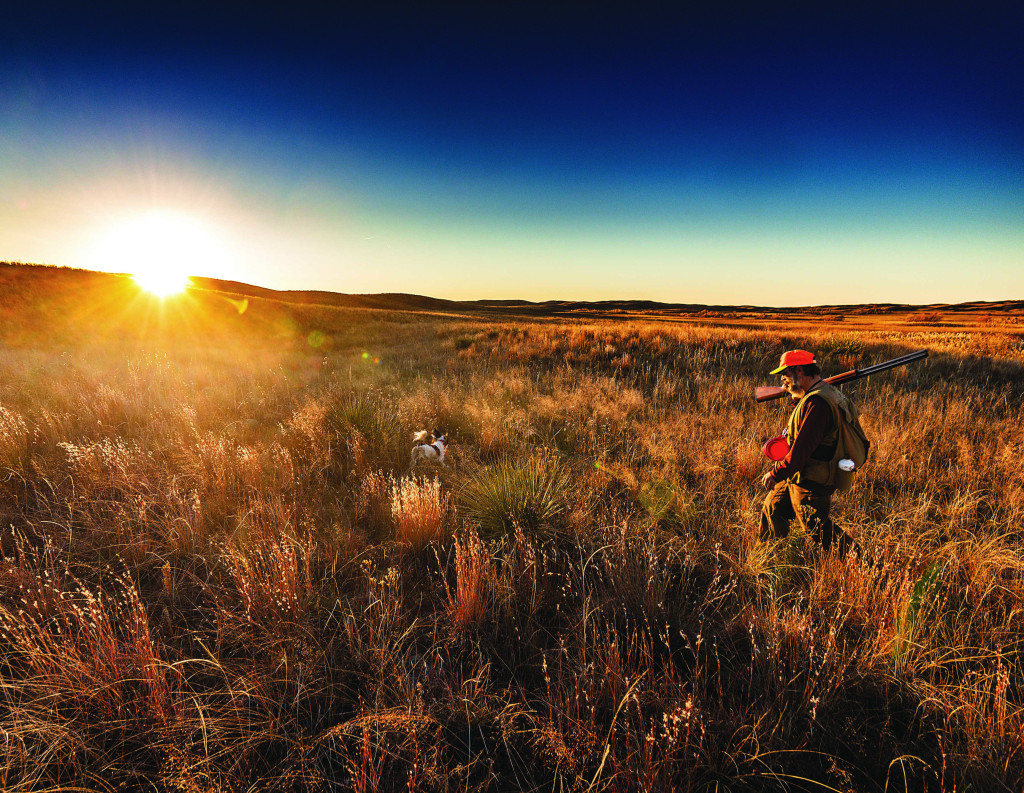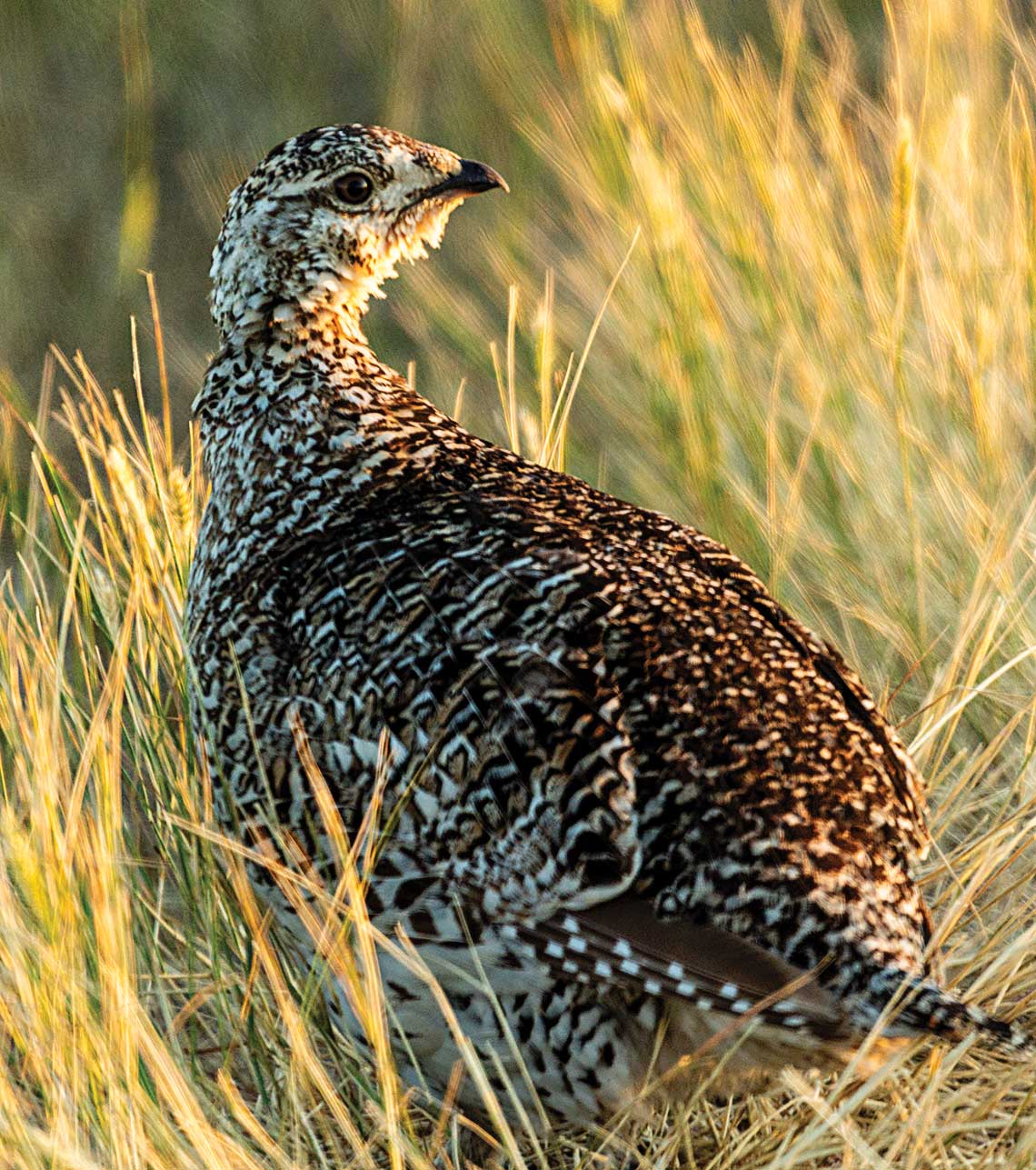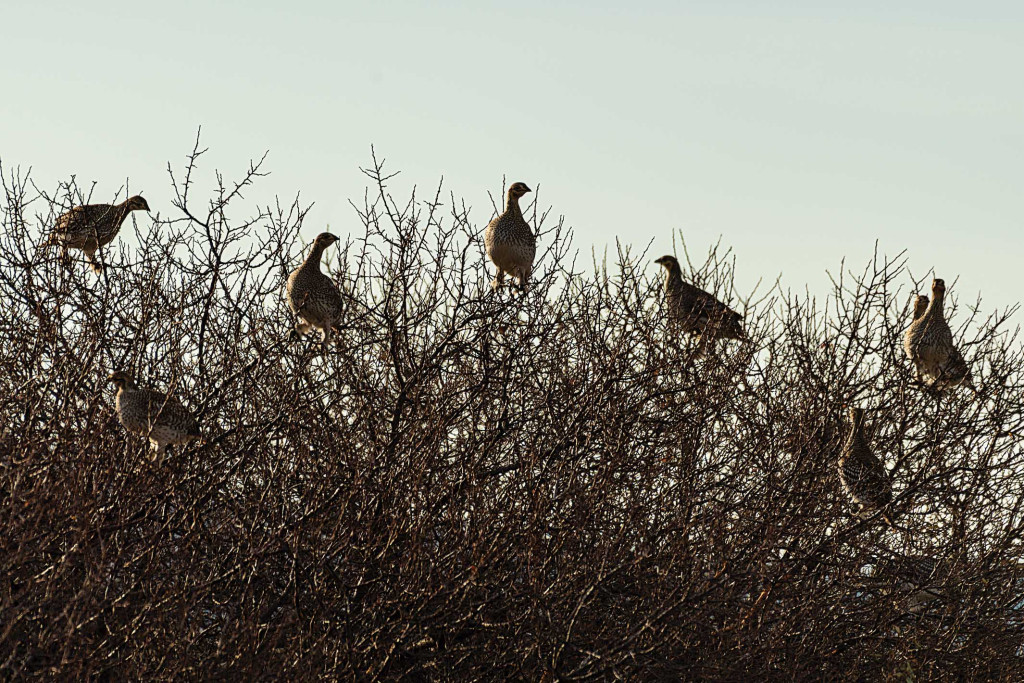
By Justin Haag
Melvin Nenneman knows birds.
As wildlife biologist for the 71,516-acre Valentine National Wildlife Refuge the past 21 years, he’s become familiar with flying creatures that range in size from the huge pelicans cruising the shallow lakes to minute grasshopper sparrows flittering about the rolling, grass-covered dunes. He and his coworkers strive to preserve and maintain the ecosystem for birds and all of the other plants and animals. From Blanding’s turtles to western prairie fringed orchids, he’s become intimate with the many species that make the Sandhills such a special place.
Nenneman’s time at the refuge also has provided opportunity to pursue a favorite pastime: hunting. Among his favorite quarries are Nebraska’s native prairie grouse.
While following Nenneman, his dog Patch and a coworker around the hills in search of upland game during an evening, the biologist shared his insights. My questions and his answers follow.
Upon first look, the Sandhills can be intimidating for a bird hunter — an expanse of rolling hills as far as the eye can see. Which areas of the hills should hunters focus?
Generally, finding hills that have good grass cover and food resources will improve your odds of finding birds. Areas that have been grazed or otherwise disturbed such that the grass is more uniformly short are not great places to look. If there is a good food source in these grazed areas, it may have birds, but they will be hard to get close to. Areas that are ungrazed, grazed early in the season so that the grass has recovered, or lightly grazed areas tend to be good places to look for prairie grouse. Talking to land managers — be it the ranchers, federal or state land managers — can be a good start in figuring out where to hunt. Vegetation height also seems to be important to grouse. They tend to avoid uniformly short, ankle-high, and uniformly tall, waist-high vegetation, with a preference for heights in the mid-shin to knee-high range. Taller vegetation may be used if there is a lot of shorter cover mixed throughout.
How much work is required to bag a grouse in the Sandhills? How’s the terrain for hiking?
Generally, a hunter should be prepared to do some walking to bag prairie grouse in the Sandhills. If grouse numbers are good and you are in the right habitat, a limit of three birds in two to three hours of walking is reasonable. If grouse numbers are down, bagging one grouse in that amount of time would be a success.
How you cover the ground can make a difference as well; taking more time to thoroughly walk an area of good cover can be more effective than covering a lot of miles in a straight line. The first steep hill to hike up always seems to be the most challenging to me. Once I’ve gotten up onto a dune ridge I plan to hunt, the terrain tends to be more rolling than steep climbs all the time. That said, it helps to do some walking ahead of the grouse hunting season if you want to enjoy your hunt.
How does grouse behavior change throughout the day?
Grouse do have habits throughout the day, which can be impacted by the weather conditions. Typically, they will leave the site that they roosted for the night early in the day to spend some time foraging. Around mid-morning, they will typically settle into a day roost to rest and digest the food that they gathered in their crop (the temporary storage in their esophagus) that morning. In the mid- to late afternoon, they will leave their roost to forage again before finding a place to roost for the night during the last bit of daylight.
On warm days, they will seek day-roost sites that have shade or cooler microclimates, which are typically the north-facing slopes of dune ridges or patches of shrubs or other tall vegetation. On colder days, they will seek enough cover to conserve energy during the day. In rainy conditions, I have found them in areas with less cover — bare patches of sand in the hills and cattle loafing areas. If you flush grouse while you are hunting, make a note of where the grouse flushed from and hunt similar locations for the time of day and season.
How does grouse hunting change throughout the season (Sept. 1-Jan. 31)?
Early in the season, young of the year grouse are often still with the hen, and consuming more animal foods —grasshoppers and other invertebrates — and it is more likely to find these birds lower in the landscape, along the edges of meadows or in meadows with open canopies that allow the birds to move freely. Areas with a lot of flowering plant diversity are good as they tend to have greater abundance of these invertebrates.

As the season goes on, all prairie grouse tend to switch to a more vegetarian diet, so finding areas with ample rose hips and poison ivy berries can be productive. They also like green vegetation — sprouting flowering plants and new grass growth is attractive forage. Later in the season, especially if there is a lot of snow, grouse will consume cedar cones (often called berries, but actually a cone) or other food sources available above the snow, such as seeds of trees and tree buds.
Early in the season, you may find grouse in the shade of a plum or chokecherry thicket, or tall but open forbs in a meadow, while late in the season you might find them on a south-facing slope where the snow has melted off. During the warm early months of the season, feeding bouts tend to be shorter as food resources tend to be more plentiful and energy requirements are lower, while in colder weather, grouse will spend more time actively feeding to meet energy demands.
Both prairie-chickens and sharptails can be found in your vicinity. Within the region, where do they reside? Does the habitat vary between species?
Both species need large expanses of grassland habitat with little development to persist in the landscape. Across the Sandhills, prairie-chickens are more common to the east and south, while sharptails are more common to the north and west in the region, with a lot of overlap of the two species across the middle region.
Generally, prairie-chickens tend to be found in and adjacent to the sub-irrigated meadows more often, while sharptails tend to be out in the Sandhill dune prairie. Prairie-chickens seem to avoid trees and shrubs more so than sharptails, and sharptails prefer some of the highest, roughest hills in the area.
Prairie-chickens seem to exhibit a short-distance migratory behavior in the late fall and winter, with many chickens apparently leaving the refuge to find center pivot agricultural crops. This is based on the observation that during the spring breeding season, there are roughly equal numbers of male sharp-tailed grouse and prairie-chickens on the refuge, while in the fall harvest, most of the birds taken on the refuge are sharptails. Researchers elsewhere in the Sandhills have documented prairie-chickens moving from the Sandhills to center-pivot agricultural areas and feedlots during the winter.
What’s the status of grouse populations on the refuge/region? I assume the harsh winter was not good for them. What weather and climate conditions do grouse need to thrive?
Prairie grouse, and sharptails in particular, are pretty well adapted to survive tough winters, and they seem to have weathered the winter of 2022-23 pretty well based on lek counts this spring. Weather seems to play a key role in determining how successful prairie grouse are during the nesting season.
Researchers have made a connection between temperature and precipitation during the nesting and brood rearing seasons on prairie grouse reproduction. Having adequate soil moisture from precipitation to grow vegetation for nesting and brood rearing is important, while having too much rain in June when the chicks are hatching has a negative impact. Similarly, warmer average temperatures in June positively influence grouse production, but days over 95 degrees Fahrenheit had a negative impact on production.

Overall warmer temperatures likely allow increased productivity in the invertebrates that chicks rely on for rapid growth and development and increases the amount of time chicks can spend foraging (versus brooding under the hen). Temperatures above 95 F can be lethal to young chicks as they are less able to regulate their body temperature and cannot travel far to find thermal cover.
Additional research looking at nest sites selected by hens has found the nest locations to have better thermal protection against cooler and warmer temperatures and to help avoid exposing eggs and the hens to the extreme warm temperatures during the day. Hot temperatures during the summer are possibly more of a problem for grouse than cold winter temperatures. Weather conditions that allow for the production of good food resources and adequate cover are important, so the “goldilocks” zone of enough rain but not too much rain, and warmth but not too much warmth is probably ideal. This summer may have been an example of good reproductive conditions for grouse; we had about average rainfall which was spaced out well across the growing season, there were no extreme hot or cold temperatures during the critical hatching and early brood rearing stages, and we avoided storms with hail. An Audubon Society analysis of potential climate change impacts on birds suggests warming temperatures and lower precipitation may combine to make Nebraska and the Sandhills less hospitable to sharp-tailed grouse, while the trend for prairie-chickens was stable. Nebraska is the southern extent of the range of sharp-tailed grouse.
Prairie grouse are not the only upland bird species in the Sandhills. Tell me about the pheasant population. Ever see any quail or partridge?
The ring-necked pheasant is an introduced game bird from Eurasia and was released in Nebraska starting in the early 1900s. The Sandhills are not prime habitat for these birds, but there is a decent population on the refuge and in pockets on surrounding ranches.
Pheasant numbers can fluctuate markedly from year to year, influenced greatly by weather. Cold and snowy winters tend to negatively affect pheasant populations as they are not well adapted to these conditions. At Valentine NWR, there is a population of pheasants that seems to sustain itself. There is enough cover in the form of cattails and tree rows to get them through most winters, and plenty of grassland habitat to sustain the population.
Pheasants tend to do well where there is a matrix of row crop fields interspersed with grasslands, but there are enough native food items for them to make a living at the refuge in the absence of agricultural crops. The pheasant density here is nothing like you would find in South Dakota, but there are usually enough here to make it fun to chase them. Bobwhite quail are usually pretty scarce here, although there is often a covey or two around. While they are legal to hunt on the refuge, I wouldn’t plan on coming here for a quail hunt. Bobwhite numbers here are typically low.
Gray partridge have been documented on the refuge in the past, but I have not encountered one here, so I would have to say encountering a partridge on the refuge would indeed be a chance encounter.
Besides the refuge, what other nearby public lands are good for upland bird hunting?
McKelvie National Forest has been good for prairie grouse recently, and the staff there has been making a map of its grazing program available each fall to help hunters decide where to go on the forest. Similar to the refuge, most of their prairie grouse harvest is sharp-tailed grouse with a good sprinkling of greater prairie-chickens in the mix. There are several Nebraska Game and Parks Commission wildlife management areas nearby that provide opportunities for both prairie grouse and pheasants — and the occasional quail. Ballard’s Marsh has a good mix of habitat that makes for a nice place to try for grouse or roosters. Merritt Reservoir and Schlagel Creek WMAs can also hold some birds.
Tell me about the wing bee. What have you learned from it?
Valentine and Crescent Lake national wildlife refuges, and Nebraska National Forest, Bessey Division and McKelvie National Forest all have locations for prairie grouse hunters to drop off one wing from each grouse they harvest. These volunteer wing return boxes have envelopes that hunters can place wings in, and they are asked to fill out some information about their hunt; providing names or address is optional, but it would be great if the date, number of hunters and number of birds harvested were filled in. Nebraska Game and Parks also collects a sample of wings from the east and west prairie grouse zones. After the grouse season closes, a group of biologists gets together for the Prairie Grouse Wing Bee — here, we go through all of the wings that hunters submitted and determine the species of grouse (sharp-tailed grouse or greater prairie-chicken, and sometimes we can pick out hybrids), and then determine from the wing molt if the bird is an adult or juvenile (or hatch year bird = bird hatched in that year).
We use this information to calculate a juvenile to adult ratio from the harvest, and if hunters provide the date of the hunt, we can backdate from the known age of a juvenile grouse to figure out an approximate hatch date.
Calculating the hatch date can shed some light on habitat conditions and how successful hens were at hatching their first nesting attempt versus a second or third try. If there is adequate nesting cover — residual vegetation from the previous year — hens can begin nesting earlier (and the peak of hatching would be earlier) than if they need to delay nesting to use the current year’s growth for concealment, which pushes the peak of hatching later. If there are two peaks in hatch dates, it shows that a number of first nesting attempts failed and the hens renested and hatched a second attempt. These data provide a measure of the harvest on these public lands, and the ratio of juveniles to adults in the harvest provides an index of grouse production. When the number of juveniles in the harvest is high relative to the number of adults, it represents a year of good production while ratios with more adults show poor reproduction. A ratio with 2.5 or more juveniles per adult in the harvest is indicative of good reproduction and a population that should grow.
Let’s talk gear. What do you prefer for a shotgun?
I am probably not going to give a very exciting answer to this, as I’m not that interested in owning every gauge of shotgun ever made or caliber of rifle produced. I tend to find a gun that works for me and stick with it, so I hunt upland birds with a 12 gauge over-and-under shotgun I purchased off the used gun rack at a Cabela’s about 15 years ago. With non-toxic shot, I use cylinder and improved cylinder choke tubes in my gun.
That said, the most effective shotgun and choke tube combination for any hunter will be a gun they can carry for hours while walking, comes up to the shoulder well, and that they can hit flying targets with. You could have the finest, most expensive shotgun on the market but if it is too heavy and doesn’t fit you well, you are going to hit less birds.

Any other gear advice?
Grouse hunting can be a minimalist pursuit. Probably most important among gear is a good pair of hiking or hunting boots as you’ll only go as far as your feet will take you. Pair good boots with clothes that keep you comfortable. I like moisture-wicking shirts that can be layered as needed and a decent pair of hunting pants that resists stickers and burs. Also, a hunting vest with enough pockets to carry adequate water for you and your canine companion, a shotgun and shells are pretty much all you need. And snacks!
The refuge requires the use of non-toxic shot. Any preference among the various types, such as bismuth, tungsten and steel?
I have not tried all the different non-toxic shot available. I started bird hunting as a relatively poor college student/biological technician/graduate student, so I used the most inexpensive non-toxic shot available, which was steel. I’ve had success using steel shot, so I have not felt the need to use any other shot types. I usually use 23⁄4-inch shells with 11⁄8 ounce of No. 4 shot traveling at 1400 fps, which seems to be a great all-around load for grouse, pheasants and ducks over decoys.
What other special regulations should people be aware of?
As far as the refuge goes, the main things to know are that we do not allow camping, fires, or the use of ATVs or UTVs; hunters are allowed access from 2 hours before sunrise to 2 hours after sunset; and vehicle travel is allowed only on refuge trails designated as open to motor vehicles.
